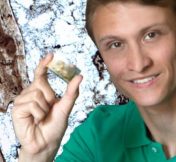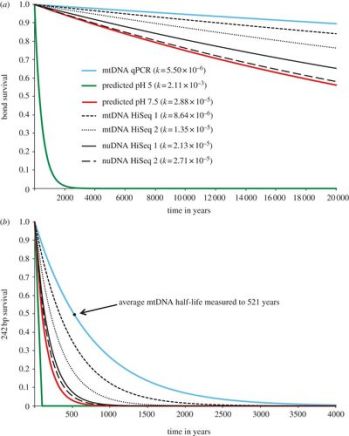An amazing article was published just this past January (2020) by the team of the well-known paleontologist Dr. Mary Schweitzer. This article details the discovery of dinosaur remains with intact dinosaur cells as well as identifiable chromosomes inside! – and even intact antigenically-active DNA! (Bailleul, 2020). This is totally unbelievable, completely unpredictable, from the Darwinian perspective on origins:
Table of Contents
Abstract:
A histological ground-section from a duck-billed dinosaur nestling (Hypacrosaurus stebingeri) revealed microstructures morphologically consistent with nuclei and chromosomes in cells within calcified cartilage. We hypothesized that this exceptional cellular preservation extended to the molecular level and had molecular features in common with extant avian cartilage. Histochemical and immunological evidence supports in situ preservation of extracellular matrix components found in extant cartilage, including glycosaminoglycans and collagen type II. Furthermore, isolated Hypacrosaurus chondrocytes react positively with two DNA intercalating stains. Specific DNA staining is only observed inside the isolated cells, suggesting endogenous nuclear material survived fossilization. Our data support the hypothesis that calcified cartilage is preserved at the molecular level in this Mesozoic material, and suggest that remnants of once-living chondrocytes, including their DNA, may preserve for millions of years. (Bailleul, 2020)
Dinosaur Cartilage:


Dinosaur DNA:

Note that DAPI, in particular, binds preferentially to double-stranded DNA in both living and dead cells. It is sequence-dependent, requiring at least three successive AT base pairs as a binding site. Specific staining of both PI and DAPI is observed inside the isolated cartilage cells of Hypacrosaurus, following the pattern seen in extant cells, but diminished in the ancient ones. This not only supports that the compound within these cells is chemically consistent with DNA, but that material is double-stranded, and of a minimum length of 6 base pairs. (Bailleul, 2020)
The Contamination Hypothesis:
 Of course, these findings are so startling as to be quite unbelievable by most scientists. Why is that? Because, most scientists believe that soft tissues, proteins, and DNA molecules cannot survive beyond a hundred thousand years or so at ambient temperatures due to the rapid nature of the decay of these molecules due to various decay mechanisms – including the inevitable effects of kinetic chemistry (where vibrating molecules gradually rearrange themselves and degenerate over time). Then, Mary Schweitzer came along and published her discoveries of original dinosaur soft tissue that was still intact, non-fossilized, and even elastic and antigenic (Schweitzer, 2005). Still, most scientists didn’t believe this to be possible given the strong scientific evidence of tissue, protein, and DNA decay over time. As recently as June, 2019, an article was published arguing that all of Schweitzer’s findings must be due to external contamination over time (Saitta, et. al., June, 2019). Of course, given additional findings like these current findings, Schweitzer remains quite confident in her original findings as well (Link). Again, she addresses the contamination hypothesis in her current paper as follows:
Of course, these findings are so startling as to be quite unbelievable by most scientists. Why is that? Because, most scientists believe that soft tissues, proteins, and DNA molecules cannot survive beyond a hundred thousand years or so at ambient temperatures due to the rapid nature of the decay of these molecules due to various decay mechanisms – including the inevitable effects of kinetic chemistry (where vibrating molecules gradually rearrange themselves and degenerate over time). Then, Mary Schweitzer came along and published her discoveries of original dinosaur soft tissue that was still intact, non-fossilized, and even elastic and antigenic (Schweitzer, 2005). Still, most scientists didn’t believe this to be possible given the strong scientific evidence of tissue, protein, and DNA decay over time. As recently as June, 2019, an article was published arguing that all of Schweitzer’s findings must be due to external contamination over time (Saitta, et. al., June, 2019). Of course, given additional findings like these current findings, Schweitzer remains quite confident in her original findings as well (Link). Again, she addresses the contamination hypothesis in her current paper as follows:
An alternative hypothesis, that the staining arises from microbial contaminant, is not supported (contra [25,29]); there is no mechanism for exogenous DNA to penetrate an intact membrane and localize to a single point specifically inside the cell, demonstrating no reactivity in any other region. We caution that only the sequencing of the material reactive to both PI and DAPI can confirm that it is dinosaurian in origin, however the combined data at the histological, cellular and molecular levels (Figs 1–4) robustly support the hypothesis that the cartilage of Hypacrosaurus has remnants of original chondrocytes, original nuclear material, and endogenous compounds chemically consistent with DNA. (Bailleul, 2020)
The basic problem still remains:
 Still, the basic reason why scientists remain so resistant to Schweitzer’s findings remains – i.e., the science supporting the decay rates of soft tissues, proteins, and DNA remains very strong and seemingly incontrovertible.
Still, the basic reason why scientists remain so resistant to Schweitzer’s findings remains – i.e., the science supporting the decay rates of soft tissues, proteins, and DNA remains very strong and seemingly incontrovertible.
“Even under the best preservation conditions at –5°C, our model predicts that no intact bonds (average length = 1 bp [base pair]) will remain in the DNA ‘strand’ after 6.8 Myr. This displays the extreme improbability of being able to amplify a 174 bp DNA fragment from an 80–85 Myr old Cretaceous bone.” (Allentoft, 2012).
This statement is particularly interesting because dinosaur bones are generally believed to have experienced greater than 20°C temperatures for tens of millions of years (Buckley, et al., 2008). Of course, higher temperatures mean more molecular movement. And, the more that long fragile molecules (like proteins and DNA) move and vibrate, the more rapidly they fall apart and fragment over time.
Other features, such as rapid desiccation and high salt concentrations, may prolong DNA survival (Lindahl 1993). However, kinetic calculations still predict that small fragments of DNA (100–500 bp) will survive for no more than 10,000 years in temperate regions and for a maximum of 100,000 years at colder latitudes (Poinar et al. 1996; Smith et al. 2001).
Also, the half-life for the average protein is similar since the “peptide bond has a half-life of 400 years” (Adv Exp Med Biol. 2009; 611: xci–xcviii). However, some proteins, such as collagen in particular, appear to have somewhat longer half-lives of ~2,000 years at ambient temperatures (Buckley, et al., 2008). Of course, this is nowhere close to the required half-life time needed to preserve proteins and/or DNA fragments for tens of millions of years.
There seems, then, to be no reasonable scientific explanation that can explain both the existence of such soft tissue remains in ancient dinosaurs while, at the same time, explaining the relatively rapid decay rates of these same soft tissues that have been observed via many detailed and very controlled experiments. It’s a real conundrum for many scientists. Schweitzer’s own suggested solutions include “DNA condensation” and “crosslinking” via iron-induced free radicals. However, these proposed solutions don’t counter the forces of decay in any significant way (Link). And, this is the reason why most scientists are still very very reluctant to accept Schweitzer’s discoveries as truly genuine.
“These organic materials… are understood to be among the least stable biomolecules over long periods of time and under the heat of deep burial during fossilization. However, it is the extreme age of the samples that is striking. This 75-million-year-old fossil is, at least, one or two orders of magnitude older than the expected preservation limits of DNA and proteins…
If the Jurassic World movies had more closely adhered to the science, perhaps they would not be so awful to watch,” Saitta told Gizmodo [a researcher from the Integrative Research Center at the Field Museum of Natural History in Chicago]. “Similarly, as scientists, we cannot get to a point in the future where our research papers are motivated by Hollywood.”
 Of course, the obvious solution is that these dinosaur remains really aren’t very old at all – that Darwinism itself is scientifically untenable on multiple levels and that the notion of life existing and evolving on this planet for hundreds of millions of years is based upon false assumptions regarding radiometric dating and other assumed measures of elapsed time on this planet (Link). In fact, this bit of evidence only adds to the already overwhelming weight of empirical scientific evidence that life on this planet is of very recent origin and that evolutionary mechanisms of random mutation and natural selection are totally inadequate to explain the origin of life or its diversity beyond the very lowest levels of functional complexity (Link).
Of course, the obvious solution is that these dinosaur remains really aren’t very old at all – that Darwinism itself is scientifically untenable on multiple levels and that the notion of life existing and evolving on this planet for hundreds of millions of years is based upon false assumptions regarding radiometric dating and other assumed measures of elapsed time on this planet (Link). In fact, this bit of evidence only adds to the already overwhelming weight of empirical scientific evidence that life on this planet is of very recent origin and that evolutionary mechanisms of random mutation and natural selection are totally inadequate to explain the origin of life or its diversity beyond the very lowest levels of functional complexity (Link).









Praise God for the truth revealed to us in the Holy Bible. “The just shall live by faith.”
Pama Cross(Quote)
View Comment